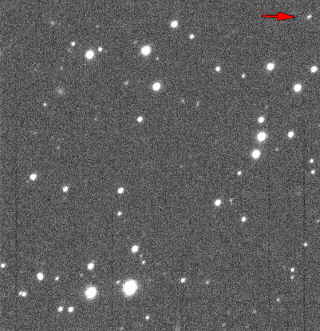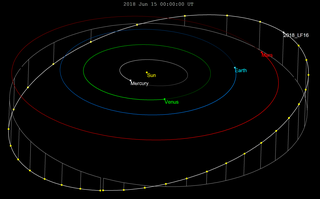Related Research Articles
(137924) 2000 BD19, provisional designation 2000 BD19, is a 970-meter asteroid and near-Earth object with the second smallest perihelion of any numbered asteroid (0.092 AU—38% of Mercury's orbital radius). With its high eccentricity, not only does 2000 BD19 get very close to the Sun, but it also travels relatively far away from it. It has the third largest aphelion of any numbered Aten asteroid and is one of a small group of Aten asteroids that is also a Mars grazer. Its orbital elements indicate that it may be an extinct comet, but it hasn't been seen displaying cometary activity so far.
1998 DK36 is a 30-meter sized asteroid and near-Earth object that is possibly the first Apohele asteroid (Atira) – an asteroid that is always closer to the Sun than Earth – detected. It was first observed on 23 February 1998, by David J. Tholen at Mauna Kea Observatory, Hawaii, but is now considered a lost minor planet.
3551 Verenia, provisional designation 1983 RD, is an Amor asteroid and a Mars crosser discovered on 12 September 1983 by R. Scott Dunbar. Although Verenia passed within 40 Gm of the Earth in the 20th century, it will never do so in the 21st. In 2028 it will come within 0.025 AU of Ceres.

4954 Eric is an eccentric, stony asteroid, classified as near-Earth object of the Amor group, approximately 11 kilometers in diameter. It was discovered by American astronomer Brian Roman at Palomar Observatory on 23 September 1990. The asteroid was named after its discoverer's son, Eric Roman.
15817 Lucianotesi is an Amor asteroid discovered on August 28, 1994, by A. Boattini and M. Tombelli at San Marcello Pistoiese.
(225312) 1996 XB27, provisional designation 1996 XB27, is a bright mini-asteroid, classified as near-Earth object of the Amor group, approximately 84 meters in diameter. It was discovered on 12 December 1996, by astronomers of the Spacewatch program at the Kitt Peak National Observatory near of Tucson, Arizona, United States.
(251732) 1998 HG49, provisional designation 1998 HG49, is a sub-kilometer asteroid and near-Earth object of the Amor group, approximately 200 meters in diameter. It was discovered on 27 April 1998 by astronomers of the Spacewatch program at the Kitt Peak National Observatory near Tucson, Arizona, United States.

(276033) 2002 AJ129, provisional designation 2002 AJ129, is a Mercury-crossing asteroid. It has the ninth-smallest perihelion of all numbered asteroids, after asteroids such as 2000 BD19, 2004 UL, and 2008 XM. It makes close approaches to all of the inner planets and asteroid 4 Vesta. The asteroid is estimated to be between 0.5–1.2 kilometers (0.3–0.7 mi) across. In January 2018 there was much media hype about this asteroid being classified as a potentially hazardous asteroid, although there is no known threat of an impact for hundreds if not thousands of years. The media has compared the size of the asteroid to the Burj Khalifa in Dubai.
(85640) 1998 OX4 (provisional designation 1998 OX4) is a sub-kilometer asteroid, classified as near-Earth object and potentially hazardous asteroid of the Apollo group.
2003 BR47 is a sub-kilometer asteroid classified as near-Earth object and potentially hazardous asteroid of the Apollo group. It was discovered on 31 January 2003 by the LINEAR program. As of 19 March 2013, its orbit is based on 170 observations spanning a data-arc of 939 days.
2006 JY26 is a near-Earth object that is also horseshoe companion to the Earth like 3753 Cruithne.
2012 FC71, also written 2012 FC71, is a small asteroid trapped in a Kozai resonance with the Earth.

(511002) 2013 MZ5, provisional designation 2013 MZ5, is a sub-kilometer asteroid, classified as a near-Earth object of the Amor group, estimated to measure approximately 300 meters (1,000 feet) in diameter. It was discovered on 18 June 2013, by astronomers with the Pan-STARRS survey at Haleakala Observatory on the island of Maui, Hawaii, in the United States. It was the 10,000th near-Earth object ever discovered.
(523662) 2012 MU2, provisional designation 2012 MU2, is a sub-kilometer asteroid on an eccentric orbit, classified as near-Earth object and potentially hazardous asteroid of the Apollo group. It was discovered on 18 June 2012 by astronomers of the Catalina Sky Survey at an apparent magnitude of 19.9 using a 0.68-meter (27 in) Schmidt–Cassegrain telescope. It has an estimated diameter of 240 meters (790 ft). The asteroid was listed on Sentry Risk Table with a Torino Scale rating of 1 on 23 June 2012.

2018 LF16 is a small Mars crossing asteroid roughly 213 m (699 ft) in diameter. It was first observed by astronomers with the Pan-STARRS survey at Haleakala Observatory on 14 June 2018. It was removed from the Sentry Risk Table on 29 July 2021. With an observation arc of 15 years the orbit is very well known and it does not make any notable approaches to Earth.
2015 ME131 (also written 2015 ME131) was a lost asteroid and a Near-Earth object (NEO). It is an Atira asteroid, which is by far the smallest group of near-Earth objects. This makes it an interior-Earth object (IEO), meaning that it has an orbit entirely confined within Earth's orbit. It was recovered on September 15, 2020 as 2020 RX8 which has extended the observation arc from 1.8 days to 5 years. It was removed from the Sentry Risk Table on February 15, 2021 after the two orbits were linked together. It was first observed on June 23, 2015, when the asteroid was more than 1 AU from Earth and had a solar elongation of 68 degrees.
(696513) 2016 NL56 (provisional designation 2016 NL56) is a near-Earth object (NEO) and a potentially hazardous object (PHA), meaning that it has an orbit that can make close approaches to the Earth and large enough to cause significant regional damage in the event of impact. It is an Apollo asteroid, meaning that it is an Earth-crossing asteroid that has an orbit larger than the orbit of the Earth. It was first observed on 12 July 2016, when the asteroid was more than 1 AU from Earth and had a solar elongation of 163 degrees.
2017 MZ8 (also written 2017 MZ8) is a near-Earth object and a potentially hazardous asteroid, meaning that it has an orbit that can make close approaches to the Earth and large enough to cause significant regional damage in the event of impact. It is an Apollo asteroid, meaning that it is an Earth-crossing asteroid that has an orbit larger than the orbit of the Earth. It was first observed on 22 June 2017, when the asteroid was about 1 AU from Earth and had a solar elongation of 131 degrees.
2017 DB120 (also written 2017 DB120) is a near-Earth object, meaning that it has an orbit which brings it into proximity with Earth. It is an Amor asteroid, meaning that its orbit does not cross Earth's orbit, but its perihelion is close to, but greater than, the aphelion of Earth. It was first observed on February 25, 2017, when the asteroid was less than 1 AU from Earth and had a solar elongation of 169°.
2017 SG33 (also written 2017 SG33) is a near-Earth object, meaning that it has an orbit which brings it into proximity with Earth. It is an Amor asteroid, meaning that its orbit does not cross Earth's orbit, but its perihelion is close to, but greater than, the aphelion of Earth. It was first observed on 25 September 2017, when the asteroid was less than 1 AU from Earth and had a solar elongation of 169°.
References
- 1 2 3 4 5 6 "JPL Small-Body Database Browser: (1998 KG3)" (2008-05-10 last obs). Retrieved 8 April 2016.
- 1 2 3 4 NeoDys-2 Retrieved 2011-09-05
- ↑ AstDys-2 Retrieved 2011-09-05
- ↑ Evans, N. W. & Tabachnik, S. (1999). Possible long-lived asteroid belts in the inner Solar System. Nature.
- ↑ JPL close-approach data Retrieved 2011-09-05